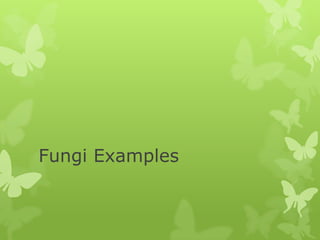
Fungi examples
- 2. Black Scab Scientific Name: Synchytrium endobioticum This fungus causes potato wart disease that hurts the production of agricultural companies. It has even been listed was a weapon in the bioterrorism list in the U.S. in 2002. It thrives in warm temperatures and originated in South America. This fungus actually has a flagellum during its motile stage of life.
- 3. Bd Scientific Name: Batrachochytrium dendrobatidis This fungus is responsible for disease found in amphibians. It has devastated and nearly caused entire species to become extinct. The fungus affects the skin of many helpless amphibians and reproduces rapidly once on a host. It can be found anywhere from cool mountain tops to lowland forests.
- 4. Baker’s Yeast Scientific Name: Saccharomyces cerevisiae This is considered the most helpful of all yeasts in that it is instrumental in baking. Its cells are often studied by scientists who have discovered many proteins from looking at this fungus. Cells can live as diploid or haploid.
- 5. Black Bread Mold Scientific Name: Rhizopus stolonifer Black bread mold forms on the surface of bread and damages its nutrients. This mold grows in temperatures between 15°C to 30°C. Because its spores are in the air, it can grow rapidly. This fungus reproduces sexually.
- 6. AM Fungi Scientific Name: Arbuscular mycorrhiza AM fungi are unique by their formation of vesicles that capture nutrients from the soil. They form a symbiotic relationship with plants that can be found in 80% of the plant families. They are native to temperate forsets and tropical rainforests.
- 7. Black Truffle Scientific Name: Tuber melanosporum These fungi grow on oak and hazelnut trees forming a symbiotic relationship between the tree and the fungus. They typically grow between autumn and late winter, specifically in Europe. They are highly prized as food, but production has declined in the past few years.
- 8. Common Morel Scientific Name: Morchella esculenta This fungus is a popular edible mushroom. They have been cultivated successfully. The pale brown cap has pits that are raised. Its stem is hallow. The common morel is native to North America.
- 9. Cellar Cup Scientific Name: Peziza cerea This fungus can be found from manure to cracks in the pavement. It has a fuzzy surface that is wrinkled in the middle. It contains paraphyese, which are sterile swollen cells that help form a surface at the fungus’s barrier by binding tightly together.
- 10. Mica Cap Scientific Name: Coprinus micaceus The mica cap is an edible fungi found in North America. It is identified by the fine radial groves that extend to the center of the fungi. It is commonly used to study cell division in basdiomycota.
- 11. Corn Smut Scientific Name: Ustilago maydis This fungus is pathogenic, specifically on maize. Despite that it can spread diseases on corn, it can still be eaten on quesadillas and it considered a delicacy in Mexico. Scientists also use it for genetic modification.
- 12. Inky Cap Scientific Name: Coprinopsis lagopus The inky cap is edible, but can sometimes be poisonous. If consumed, it is usually eaten with alcohol. This fungi is native to the Northern Hemisphere., often found in urban areas.
- 13. False Earthstars Scientific Name: Astraeus hygrometricus The false earthstar is an inedible fungi that has a fruit body that opens up like a star. It is found in temperate and tropical regions throughout the world. It was declared mushroom of the year in 2005
- 14. Dune Stinkhorn Scientific Name: Phallus hadriani The dune stinkhorn is found in the tropical regions in the world. Its stalk if spongy and hallow. This stinkhorn reproduces internally and releases a distinct odor when attempting t disperse its spores.
- 15. Witches’ Butter Scientific Name: Exidia nigricans Witches’ butter is a wood-rotting species of fungi found in the Northern Hemisphere. It is found on broad leaves and branches. The name derives from the belief that witches milk cows at night and spread their evil butter around afterwards.
- 16. Brown Blusher Scientific Name: Amanita rubescens The brown blusher is found in Europe and eastern North America. It has a powerful smell and is often attacked by ants. It is an edible fungi and is unique in that its flesh turns pink when bruised or exposed to air.
- 17. Indigo Milk Cap Scientific Name: Lactarius indigo The indigo milk cap is located in North America, Central America and East Asia. It is an edible fungi that oozes milk, or latex, when cut. Over 95% if this bright blue fungus is moisture.
- 18. Purple-Spored Puffbal Scientific Name: Calvatia cyathiformis This fungus is named for its purple-brown spots. It is edible until it turns a tan color. It is common in North American and Australian prairies. As it ages, this fungus’s skin evolves from smooth and round to irregular.
- 19. Snow Fungus Scientific Name:Tremella fuciformis This fungus is found in the tropics of the world. It is parasitic and grows on dead leaves or branches. Despite this, China cultivates the fungus for its added texture in food.
- 20. Cloud Ear Fungus Scientific Name: Auricularia polytricha This fungus is often used in Asian cuisine, not for its taste, but for its texture. In fact, this fungus is near tasteless. It is found on dark wood and is identified by its gray-brown color.
- 21. Sugarcane Smut Scientific Name: Ustilago scitaminea Sugarcane smut stunts the growth of sugarcane. Its spores are dispersed all over through the wind. It is mostly native to Central America, South America and Australia. Resistants are used to prevent the problems this fungus causes to sugarcane production companies.
- 22. Scaly-Stalked Puffball Scientific Name: Battarrea phalloides This puffball is inedible and is found in dry, sandy locations. It looks very much like a mushroom, even though it is not one. Its stem is very woody-looking and can grow up to 15 inches long.